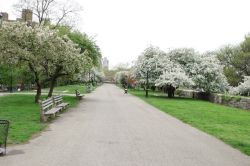Riverside Park
Hippo Playground
This text is part of Parks’ Historical Signs Project and can be found posted within the park.
The hippopotamus (Hippopotamus amphibious), which can measure up to 16 feet (5 meters) long and weigh almost 4 tons (3600 kilograms), is among the world’s largest land mammals. Although fossils indicate that hippopotami once resided in parts of India and Europe, today they are found only in the rivers of sub-Saharan Africa. Hippos are semi-aquatic, herbivorous animals, who spend most of their day underwater and usually venture onto land at night to look for food. Despite their size, they can swim swiftly underwater and run quickly on land. They live in groups of 10 to15, although herds of up to 100 have been sighted. Because many people hunt hippos for their meat and make whips from their skins, the hippopotamus population has been steadily decreasing.
Hippo Playground is one of the smaller parks within Riverside Park. Calvert Vaux (1824-1895) and Samuel Parsons (1819-1906) laid out the southern end of Riverside Park in 1872 to enhance Frederick Law Olmstead’s (1822-1903) design for Riverside Drive. The City constructed a number of monuments on the property, the best known being Grant’s Tomb on 125th Street. Robert Moses significantly expanded the park in 1937. In 1980 it was recognized as a scenic landmark by the New York City Landmarks Preservation Commission. Today the park extends from 72nd Street to 158th Street. It is home to 14 playgrounds, a marina on 79th Street, as well as a series of soccer fields, baseball diamonds, basketball courts and dog runs.
The property that is now Hippo Playground, on 91st Street, was acquired in 1937 as part of the Riverside Park expansion. The site was developed later that year and was known as the 91st Street Playground. In 1993, ‘The Playground Project’, a neighborhood organization, raised $120,000 to fund the construction of hippopotamus art. Designed by Bob Cassily, the sculptures were installed in the middle of the playground. The park was appropriately renamed Hippopotamus Playground. For the 1993 renovation, Council Member Ronnie Eldridge contributed $67,000. In 1997, she provided $100,000 in additional funding for a new jungle gym and swings. Today Hippo Playground offers a public restroom and park house, swings with safety surfacing, wooden play equipment and slides, green metal play equipment, a spray shower, picnic tables, benches, sand pit, and a drinking fountain. The large hill on the east side of the playground is a popular sledding area for neighborhood children during the winter. Honey locusts (Gleditsia triacanthos) give shade and dappled light to the site.
Hippopotamus Playground is maintained by Parks and The Playground Project. This non-profit group, formed in 1990, is dedicated to the preservation of the park. The group allocates much of its funds to provide park attendants for the playgrounds.
Hippo Playground is one of the smaller parks within Riverside Park. Calvert Vaux (1824-1895) and Samuel Parsons (1819-1906) laid out the southern end of Riverside Park in 1872 to enhance Frederick Law Olmstead’s (1822-1903) design for Riverside Drive. The City constructed a number of monuments on the property, the best known being Grant’s Tomb on 125th Street. Robert Moses significantly expanded the park in 1937. In 1980 it was recognized as a scenic landmark by the New York City Landmarks Preservation Commission. Today the park extends from 72nd Street to 158th Street. It is home to 14 playgrounds, a marina on 79th Street, as well as a series of soccer fields, baseball diamonds, basketball courts and dog runs.
The property that is now Hippo Playground, on 91st Street, was acquired in 1937 as part of the Riverside Park expansion. The site was developed later that year and was known as the 91st Street Playground. In 1993, ‘The Playground Project’, a neighborhood organization, raised $120,000 to fund the construction of hippopotamus art. Designed by Bob Cassily, the sculptures were installed in the middle of the playground. The park was appropriately renamed Hippopotamus Playground. For the 1993 renovation, Council Member Ronnie Eldridge contributed $67,000. In 1997, she provided $100,000 in additional funding for a new jungle gym and swings. Today Hippo Playground offers a public restroom and park house, swings with safety surfacing, wooden play equipment and slides, green metal play equipment, a spray shower, picnic tables, benches, sand pit, and a drinking fountain. The large hill on the east side of the playground is a popular sledding area for neighborhood children during the winter. Honey locusts (Gleditsia triacanthos) give shade and dappled light to the site.
Hippopotamus Playground is maintained by Parks and The Playground Project. This non-profit group, formed in 1990, is dedicated to the preservation of the park. The group allocates much of its funds to provide park attendants for the playgrounds.
Check out your park's Vital Signs
Clean & Safe
$358.5M
Recent Investment
Green & Resilient
3.9K
Mapped Trees
Empowered & Engaged Users
Share your feedback or learn more about how this park is part of a
Vital Park System

Know Before You Go
West 79th Street Boat Basin
The 79th Street Boat Basin is closed and is anticipated to reopen in 2028.
Related inquiries may be sent to boatbasin@parks.nyc.gov
Related inquiries may be sent to boatbasin@parks.nyc.gov
Riverside Park (79th Street)
The 79th Street Boat Basin marina is currently closed. No vessel dockage, moorage, anchorage or launch services are available. The marina will be dredged and reconstructed to modern codes and standards. The marina is anticipated to reopen in 2028.
Related inquiries may be sent to boatbasin@parks.nyc.gov
Related inquiries may be sent to boatbasin@parks.nyc.gov


